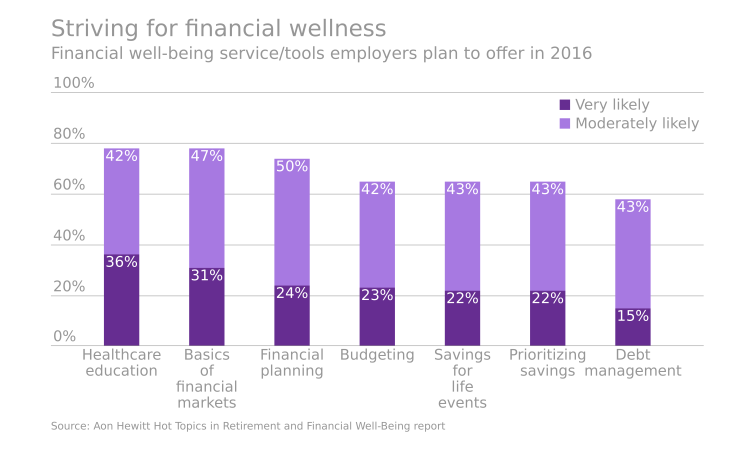The term “financial wellness” has received a lot of buzz over the past few years, and corporations are jumping on board at accelerating rates. According to a

Where did this increased interest in employee financial wellness come from? In the aftermath of the recent economic recession, today’s workplace remains fraught with financial stress. According to
Why prioritize financial wellness programs?
By offering financial wellness education and counseling programs, companies can help lighten the load for employees, improve morale and increase workforce performance and efficiency. When workers are making wise choices about spending, saving and investing, they enjoy more stability and the company’s culture flourishes.
When workers are making wise choices about spending, saving and investing, they enjoy more stability and the company’s culture flourishes.
Specifically, financial wellness programs can benefit your organization in several ways:
1. Productivity. According to a survey by MetLife, Inc.,
It’s clear that personal financial difficulties are distracting a significant portion of the American workforce — but how can financial wellness programs make a difference?
2. Contagious engagement. Engaged employees are those who go the extra mile — they’re not just satisfied with their jobs and employers, they’re committed to the mission of their company with an enthusiasm that’s contagious. Worker engagement has a mighty impact on business growth:
How can you inspire that kind of enthusiasm in your workers? It depends on a combination of factors: inspiring trust, showing deep care for employees, and striving to communicate clearly about company goals. Financial wellness programs can play a vital part in creating a work environment that’s supportive and low-stress — two elements that contribute to employee engagement.
Also see: “
3. Long-term retention. When workers are productive and engaged, excited about their jobs and supportive of company goals, they’re likely to stay put.
QLI, a nonprofit organization in the rehabilitation industry, noticed a decade ago that many of its employees faced financial crises. The organization responded by offering a financial training program. Since its introduction,
Are your employees getting sick from the financial flu? Employees who are financially stressed may take more sick days and be less productive when they are at work. Watch out for these financial flu symptoms and adjust your financial wellness program accordingly.
4. Differentiation and reputation. Offering a financial wellness program — or a better financial wellness program — can help your company stand apart from competitors, building your reputation as a desirable employer. A recent survey conducted by Harris Poll found that
By creating even a modest financial wellness program and communicating its availability to your workers, you’ll set yourself apart, gaining a competitive advantage against other employers.
Also see: “
Creating a financial wellness program is a win-win decision — when your employees benefit, so does your company. And the investment isn’t as great as you might think — according to the Consumer Financial Protection Bureau, private employers spend an average of $144 per worker per year on financial wellness programs.
Add up the combined benefits of higher productivity, engagement and retention, and you’ll find that a financial wellness program will more than pay for itself.






